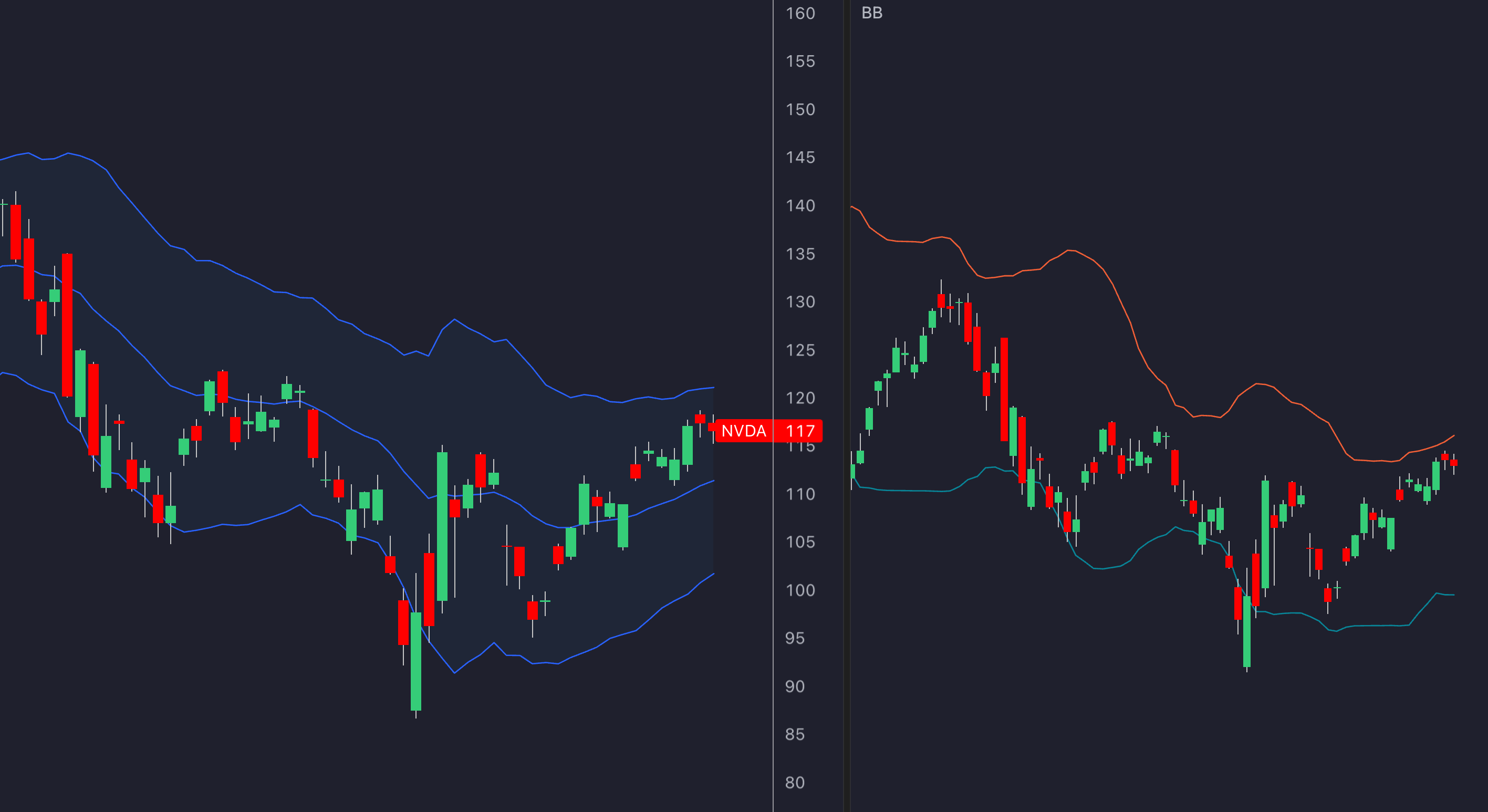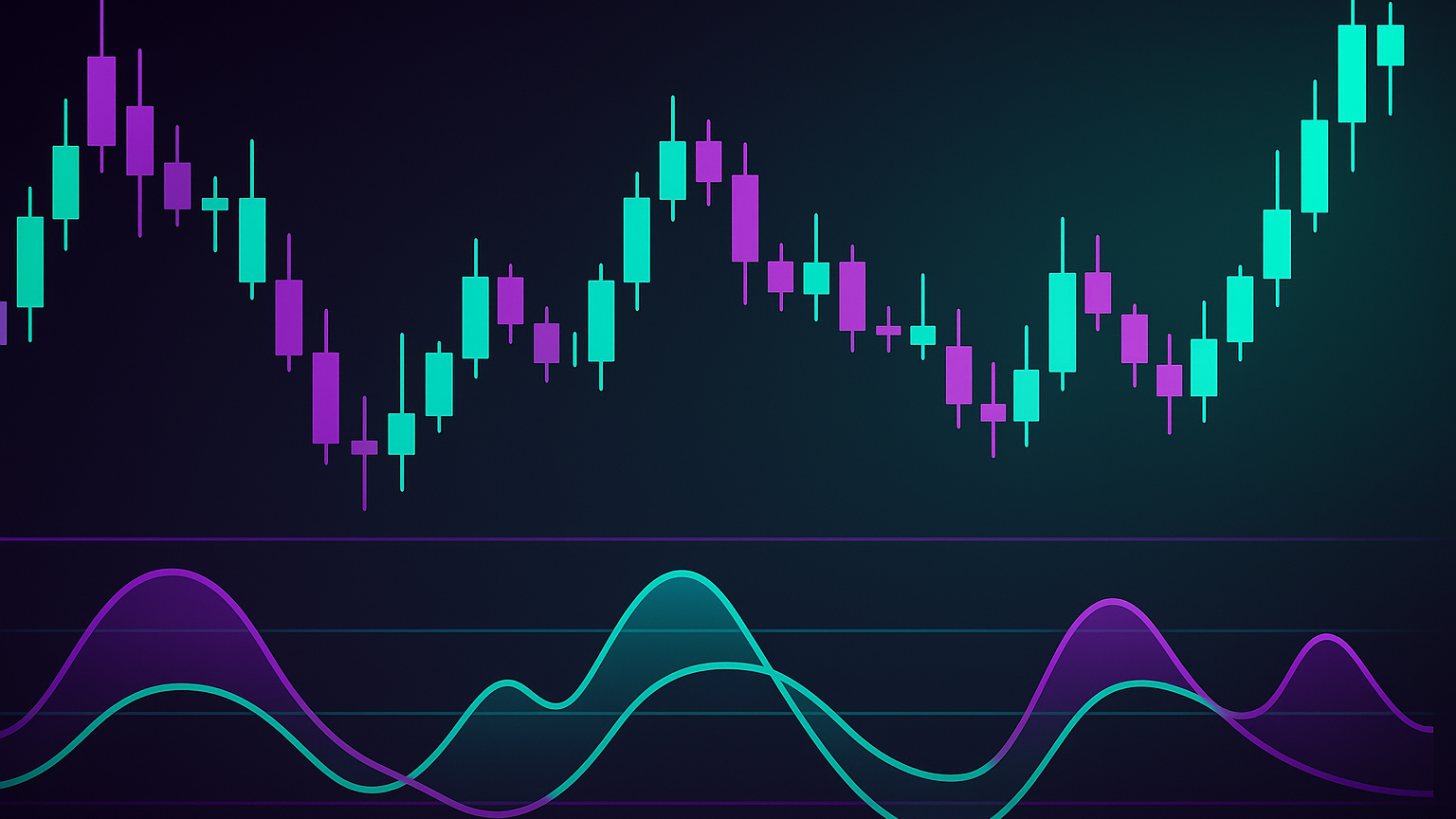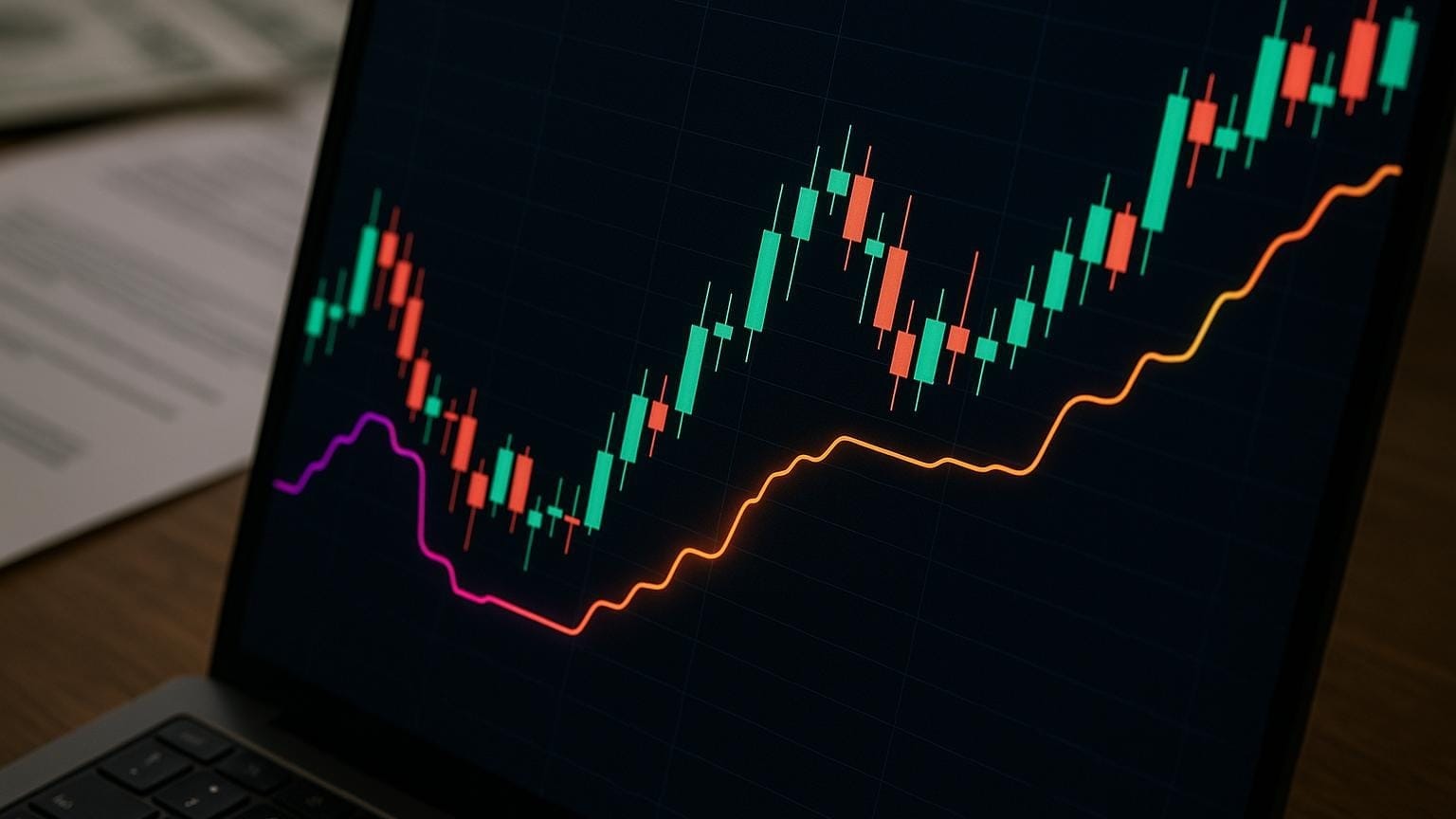Explore how band indicators like Bollinger Bands and Keltner Channels aid in understanding market volatility and enhancing trading strategies.
Band indicators, like Bollinger Bands and Keltner Channels, help traders understand market volatility and identify trading opportunities. They adjust dynamically to market conditions, expanding in high volatility and contracting in calm periods. Here's a quick overview:
- Bollinger Bands: Use a simple moving average (SMA) and standard deviation to highlight overbought/oversold conditions. Best for range-bound markets.
- Keltner Channels: Use an exponential moving average (EMA) and average true range (ATR) for smoother signals. Ideal for trending markets.
Quick Comparison:
| Feature | Bollinger Bands | Keltner Channels |
|---|---|---|
| Volatility Measure | Standard Deviation | Average True Range (ATR) |
| Moving Average Type | Simple (SMA) | Exponential (EMA) |
| Best Use | Range-bound markets | Trending markets |
| Price Containment | ≈ 95 % of price action | ≈ 90 % of price action |
To trade effectively, combine these indicators with tools like RSI or MACD for confirmation, and adjust settings based on market conditions. Use them to spot trends, confirm breakouts, and manage risks with stop-loss levels (LuxAlgo Library).
Keltner Channels vs Bollinger Bands: Understanding Volatility Indicators
Bollinger Bands Analysis
Bollinger Bands help track market volatility and highlight important price movements.
Parts of Bollinger Bands
Bollinger Bands are made up of three key components that provide insight into market behavior:
| Component | Description | Calculation Method |
|---|---|---|
| Middle Band | 20-day Simple Moving Average (SMA) | Sum of closing prices / 20 |
| Upper Band | A level above the SMA based on volatility | SMA + (2 × Standard Deviation) |
| Lower Band | A level below the SMA based on volatility | SMA − (2 × Standard Deviation) |
The 2-standard-deviation multiplier accounts for about 95 % of price movements. When prices move beyond the bands, it often signals overbought or oversold conditions. These components provide the foundation for analyzing market trends.
Reading Bollinger Band Signals
Traders use Bollinger Band signals by observing changes in the band width and price interactions:
- Narrow bands (squeeze): Indicates reduced volatility and often precedes a major price movement.
- Widening bands: Signals increasing volatility and the potential for a developing trend.
When prices touch the upper band, it can suggest overbought conditions, especially if volume is high. Conversely, touching the lower band may indicate oversold conditions. The slope of the middle band helps confirm the direction of the trend.
Trading with Bollinger Bands
Traders can use Bollinger Bands to develop actionable strategies based on these signals.
For example, in a USD/JPY scenario, if the upper band is 109.50, the middle band 109.00, and the lower band 108.50, a squeeze might suggest entering a long position at 109.00, targeting 109.50, with a stop-loss at 108.50.
Here are some common strategies:
- Momentum Trading
A strong breakout above the upper band, especially with high volume, may signal continued upward momentum. Traders often place stop-loss orders below recent support levels to limit risk. - Mean Reversion
If prices move beyond the bands, waiting for a reversal signal before entering a trade back toward the middle band can be effective. This approach works well in markets that oscillate within a range. - Risk Management
Combining Bollinger Band signals with other tools like RSI or MACD, along with identifying support or resistance levels, helps confirm trade setups and manage risk better.
Next, we’ll dive into Keltner Channels, which offer a different perspective on volatility and trend analysis.
Keltner Channels Guide
Keltner Channels are a tool used to measure market volatility, helping traders spot trends and potential breakout points.
Keltner Channel Basics
Keltner Channels have three main parts:
| Component | Description | Calculation |
|---|---|---|
| Middle Line | 20-period Exponential Moving Average (EMA) | EMA of closing prices |
| Upper Band | Acts as a resistance level | EMA + (ATR × multiplier) |
| Lower Band | Acts as a support level | EMA − (ATR × multiplier) |
The channel width is determined by the Average True Range (ATR), which measures the strength of price movements. Traders often adjust settings based on their style: short-term traders might use a 10-period EMA with a multiplier of 1, while longer-term traders may opt for a 20-period EMA and a multiplier of 2.
Keltner vs Bollinger Comparison
Although Keltner Channels and Bollinger Bands both measure volatility, they have distinct differences:

| Feature | Keltner Channels | Bollinger Bands |
|---|---|---|
| Volatility Measure | Average True Range (ATR) | Standard Deviation |
| Moving Average Type | Exponential (EMA) | Simple (SMA) |
| Channel Width | More consistent | Expands during high volatility |
| Best Use | Spotting trends and breakouts | Identifying reversals and ranges |
| Price Containment | Covers ≈ 90 % of price action | Covers ≈ 95 % of price action |
Keltner Channel Trading Methods
- Trend Identification
Look for consecutive closes above or below the middle line to confirm an ongoing trend. - Breakout Trading
When price breaks above the upper band with strong volume, it signals a potential long trade. Place your stop-loss just under the middle line and set profit targets based on your risk-reward plan. - Risk Management
Use additional tools like RSI to validate overbought or oversold conditions before making decisions.
“The Keltner Channel can be applied to any market and trading instrument. It has few settings and is easy to learn. In addition, it generates profitable signals and suits different trading styles.”
- Alex Rodionov
Combining Keltner Channels with other indicators can help fine-tune your trading approach.
Band Indicator Trading Tactics
Combining Technical Indicators
Band indicators become much more effective when paired with other technical tools that provide a variety of insights. The goal is to use indicators that complement each other rather than duplicate signals.
| Indicator Type | Recommended Pairing | Purpose |
|---|---|---|
| Momentum | RSI, MACD, Stochastic | Identify overbought or oversold conditions |
| Trend | ADX, Moving Averages | Assess trend strength |
| Volume | Volume Analysis, OBV | Confirm breakout reliability |
For example, with the BB/KC Squeeze, you can combine Bollinger Bands and Keltner Channels to spot potential trade setups. When Bollinger Bands narrow within the Keltner Channels, this often signals a buildup of pressure. Momentum indicators like RSI or MACD can then help confirm the direction, while volume tools verify the strength of the breakout.
Volatility-Based Trade Timing
Pairing indicators is just the start—timing your trades during low-volatility periods can help you catch breakout opportunities.
Key signals to watch for:
- Squeeze Formation: Bollinger Bands tighten within the Keltner Channels, signaling a potential breakout.
- Breakout Confirmation: Price moves beyond either the upper or lower Bollinger Band.
- Trend Direction: The middle band (usually a 20-day SMA) can indicate whether the overall trend favors bullish or bearish moves.
Risk Control Methods
Once you've identified an entry point, managing risk becomes critical. Band indicators can serve as reference points for stop-losses and position adjustments:
- Place stop-loss orders just below the lower Bollinger Band for long trades or above the upper Bollinger Band for short trades.
- Set profit targets using historical price data or technical patterns like Fibonacci retracements or key support/resistance levels.
Mistakes to Avoid
Spotting False Signals
Band indicators can sometimes mislead traders, especially in sideways or choppy markets. To improve accuracy, consider multiple factors when assessing setups.
| Market Condition | Warning Signs | Verification Method |
|---|---|---|
| Sideways Market | Frequent crossovers without clear direction | Use ADX to evaluate trend strength |
| Low Volume Breakout | Price moves beyond bands but with weak volume | Confirm with volume indicators |
| Counter-Trend Signals | Signals opposing the prevailing trend | Analyze higher timeframes for clarity |
Fine-tuning indicator settings to align with current market conditions is crucial to reduce these errors.
Market Condition Adjustments
To align with different market environments, adjust your indicator settings based on volatility and trends:
- High Volatility Markets: Increase standard deviation levels (e.g., to 2.5 or 3) to filter out misleading signals.
- Low Volatility Markets: Opt for a 10-15 period setting to capture quicker signals.
- Trending Markets: Use trend-following tools like ADX to confirm market direction.
In trending conditions, combining Bollinger Bands with tools like the Relative Strength Index (RSI) can help pinpoint potential reversals and refine entry/exit timing.
Testing and Improvement
Refining your strategy is an ongoing process. Regularly test and adjust your approach based on market conditions and performance data.
- Performance Metrics
Monitor win rates, average win/loss ratios, and maximum drawdown across different market types. - Signal Validation
Identify which indicators consistently confirm your trades. - Risk Management
Experiment with position sizes and stop-loss strategies relative to the bands. This helps optimize risk-reward ratios while keeping risk under control.
Keep in mind that band indicators are inherently lagging, so they should be used alongside other tools for better decision-making.
Summary and Action Steps
Main Points Review
Band indicators measure market volatility and identify trading opportunities. Bollinger Bands rely on standard deviation to create dynamic support and resistance levels, capturing about 95 % of price movements within two standard deviations of the simple moving average. Keltner Channels, meanwhile, use the Average True Range (ATR) for smoother band movements, making them well-suited for trending markets.
Here's a brief comparison:
| Feature | Bollinger Bands | Keltner Channels |
|---|---|---|
| Calculation Base | Standard Deviation | Average True Range (ATR) |
| Price Reference | Closing Price | Typical Price (H + L + C)/3 |
| Volatility Response | More reactive | Smoother movement |
| Best Market Conditions | Range-bound markets | Trending markets |
Getting Started
Follow these steps to incorporate band indicators into your trading approach:
- Start with standard settings: 20-period SMA with 2 standard deviations for Bollinger Bands and 20-period EMA with a 2.0 ATR multiplier for Keltner Channels.
To enhance your analysis, consider adding:
- Trend Confirmation: Use an ADX indicator to confirm the strength of trends before acting on band signals.
- Volume Analysis: Keep an eye on trading volume to validate breakout signals.
- Momentum Check: Include tools like RSI or MACD to assess overbought or oversold conditions.
A backtest of a Keltner Channel strategy showed strong results when paired with trend confirmation techniques. These steps can help you refine your trading decisions and improve outcomes.








